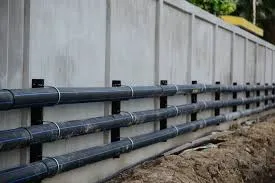szept . 04, 2024 03:47 Back to list
pvc-o pipe
Understanding PVC-O Pipes The Next Generation of Piping Solutions
Polyvinyl Chloride (PVC) has long been a staple in the piping industry due to its durability, affordability, and versatility. However, advancements in material technology have led to the emergence of PVC oriented (PVC-O) pipes, which offer a range of enhancements over traditional PVC pipes. This article delves into the characteristics, advantages, applications, and sustainability aspects of PVC-O pipes.
What is PVC-O?
PVC-O is a type of PVC that has been molecularly oriented, meaning that the molecular structure of the PVC is aligned in the direction of the stress during manufacturing. This alteration results in a product that has a significantly higher impact resistance, tensile strength, and resilience compared to standard PVC. The orientation process also enhances the overall mechanical properties of the pipe, making it an ideal choice for various applications.
Key Advantages of PVC-O Pipes
1. Improved Strength-to-Weight Ratio One of the most significant advantages of PVC-O pipes is their exceptional strength-to-weight ratio. They are lighter than traditional PVC pipes, which not only makes them easier to handle and install but also reduces transportation costs.
2. Increased Durability Due to their molecular orientation, PVC-O pipes can withstand higher pressures and adverse environmental conditions. This durability results in a longer lifespan, reducing the need for frequent replacements and repairs.
3. Resistance to Corrosion and Chemicals Like standard PVC pipes, PVC-O pipes are resistant to corrosion, making them suitable for various fluid transportation applications. Their resistance to a broad range of chemicals ensures that they can be used in diverse environments without degrading.
pvc-o pipe

4. Environmental Advantages PVC-O’s manufacturing process requires less material than traditional PVC, leading to a reduced environmental footprint. Moreover, the longer lifespan of these pipes means less waste over time, contributing to sustainability efforts.
5. Cost-Effectiveness Despite some higher initial costs, the long-term savings associated with reduced maintenance and replacement needs make PVC-O pipes a cost-effective choice for many projects.
Applications of PVC-O Pipes
PVC-O pipes are versatile and can be used in various applications, including
- Water Distribution Their ability to handle high pressure makes them suitable for municipal and industrial water distribution systems. - Irrigation Systems The lightweight nature facilitates easy installation, making them an ideal choice for agricultural irrigation. - Sewage Systems PVC-O pipes offer corrosion resistance, making them effective for sewage and drainage systems. - Telecommunication and Electric Conduits Their durability and low friction properties allow for efficient installation in telecommunication and electric systems.
A Sustainable Future
As industries increasingly focus on sustainability, PVC-O pipes rise to the occasion with their reduced environmental impact and longevity. The focus on sustainable materials and practices in construction and infrastructure development will likely see PVC-O pipes becoming the preferred choice for many engineers and contractors.
In conclusion, PVC-O pipes represent a significant advancement in pipeline technology. Their unique properties and benefits set them apart from traditional PVC and open up new possibilities for efficient, durable, and sustainable piping solutions in various industries. As we continue to innovate and prioritize environmental responsibility, PVC-O pipes will play a crucial role in shaping the future of piping systems.
-
Durable PP Rigid Sheet: Lightweight, Chemical Resistant Solutions
NewsAug.21,2025
-
PVC Grey Sheet for Extraction: Chemical Resistant & Durable
NewsAug.19,2025
-
Durable PVC Pipe Fittings for Plumbing & Irrigation Needs
NewsAug.18,2025
-
HDPE Steel Belt Reinforced Spiral Corrugated Pipe | High Strength
NewsAug.17,2025
-
HDPE Pipe Fittings: Durable, Leak-Proof Solutions
NewsAug.16,2025
-
Premium CPVC Sheet: High-Temp & Chemical Resistant Solutions
NewsAug.15,2025

